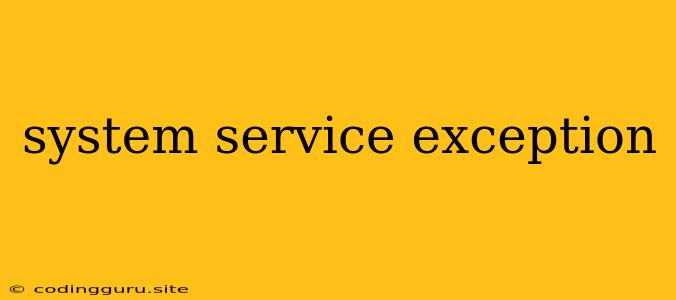What is a System Service Exception?
A system service exception is a type of error that occurs when a program attempts to access or use a system service that is not available or is not functioning correctly. This can be due to a variety of factors, including:
- The service itself is not running: The service might be stopped, disabled, or even missing.
- The service is experiencing an internal error: The service might be malfunctioning and unable to fulfill the request.
- The program does not have the necessary permissions to access the service: This could be due to a lack of user privileges or a misconfiguration in the system's security settings.
- The system resources are insufficient: The system might be running out of memory, disk space, or other critical resources needed for the service to function.
How to Diagnose a System Service Exception
- Identify the Specific Service: First, you need to figure out which service is involved. This information might be directly reported in the error message or can be deduced from the context where the exception occurred.
- Check the Service Status: Use the appropriate tools for your operating system to check if the service is running and if it's configured to start automatically.
- Examine the System Logs: Look for error messages related to the service in the system event logs. These logs often contain valuable information about the cause of the exception.
- Review System Permissions: Ensure that the program attempting to access the service has the necessary permissions.
- Check for System Resource Issues: Monitor the system's resources like memory and disk space to rule out any potential limitations.
Common Examples of System Service Exceptions
- Windows: You might encounter errors like "The service is not available", "Error 1053: The service did not respond to the start or control request in a timely fashion", or "Error 1068: Dependency service or group failed to start."
- Linux: Linux systems typically display error messages like "Failed to start <service name>" or "Job for <service name>.service failed because the control process exited with error code 1."
- Network Services: Network errors like "Connection refused" or "Host unreachable" can often point to a system service exception related to network components.
How to Fix System Service Exceptions
The solution will depend on the specific cause of the error. Here are some common steps:
- Restart the Service: If the service has crashed or is not responding, a simple restart might resolve the issue.
- Enable the Service: Ensure the service is configured to start automatically upon system boot.
- Check for Updates: Outdated service versions could cause problems. Update the service to the latest version if available.
- Verify Dependencies: Make sure that any dependencies required by the service are functioning correctly.
- Adjust System Permissions: Grant the program accessing the service the necessary permissions.
- Free up System Resources: Close unnecessary programs or clean up disk space to ensure enough resources for the service.
- Consult Documentation and Online Resources: Refer to official documentation or search for solutions online specific to the service and operating system you are using.
Conclusion
System service exceptions can be frustrating, but they are often manageable with a systematic approach. By identifying the specific service, analyzing system logs, and checking for errors, you can diagnose and fix most system service exceptions effectively. Remember to use appropriate tools and resources based on your operating system and specific service in question.
